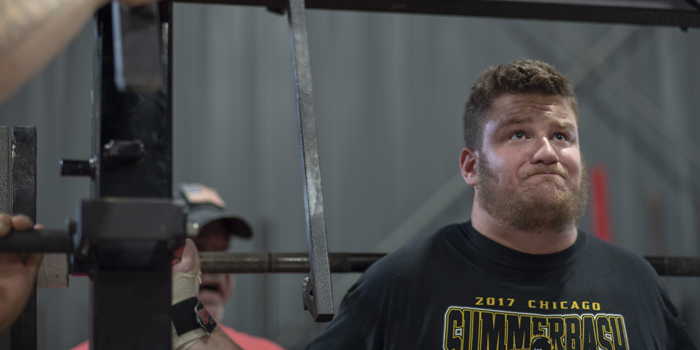
Over winter break this year, I got to listen to Nate Harvey give a presentation; then, I read his ebook, which I highly recommend. Based on the information I obtained from him, I decided to try out a conjugate-based system with two of my teams, men’s soccer and women’s volleyball, during the spring semester. What I describe in this article is what we did, what my thought process was behind a lot of it, how I felt it worked, and what changes I plan to make moving forward.
Background
We began to train during the last week of January, so we had six weeks before spring break. When the teams returned from spring break, they began their non-traditional season, or spring ball. Men’s soccer played games just about every weekend and practiced every day, so essentially, they were in-season without mid-week games. We trained three times per week on Monday, Wednesday, and Friday at 10 AM for about an hour, prior to practice. Women’s volleyball also trained on the same three days, but Monday players would come in two groups during the day, Wednesday players trained as a team at 2:30 PM, and Friday players trained as a team at 11:30 AM.
NEW: I Read a Book: Re-Implementing Conjugate Training with More Knowledge
They practiced daily at 5 PM and had a couple of weekend matches/tournaments. All of the athletes had trained with me throughout the fall using a lot of the exercises below, so there was a small training age, even for the freshmen.
Warm-up
Before the teams began spring ball, we began sessions with a dynamic warm-up, sprinting or shuttles, and a circuit to prepare for our main exercise. On the upper-body-focused days, we would run shuttles on the turf in our weight room. These were 60-, 100-, 150-, or 300-yard shuttles. We would then do some medball throws, upper-back-strength work, and a light pressing variation, sometimes with a static core exercise. On lower-body days, we did sprints of between 5 and 20 yards, either on our turf or upstairs on the track. We would follow this with a mini-band exercise, a jump, and a light squat or hamstring exercise. Once both teams began spring ball, we dropped the running.
Weekly Rotating Set-up for Main Exercise
There are four days in conjugate programming: max and dynamic days for both the upper and the lower body. We spread the four days out using the plan that Harvey discussed in the e-book. So, Monday was ME upper, Wednesday DE lower, Friday DE upper, Monday ME lower, and so on. Here is what we did from the end of January to spring break.
Day 1 – ME Upper
We alternated between the wide grip and the middle grip on our Swiss bars. Soccer bench pressed every week. We began to work up to a five rep max, but it ultimately became APRE 3. We would also vary the pulling movement paired with the press, and during a couple of weeks, we pressed without a superset. We also varied the DB variation every two weeks. Finally, we got some lower-body or lower-back exercises in, as we were training only three days per week.
Day 2 – DE Lower

During the first six weeks, our dynamic effort work was done based on percentages or based on the eyeball method (if the coach thinks it looks fast, you can add a little weight). This was easier to do with volleyball because they were a much smaller group and we would have only two or three racks going at once. Over spring break, we installed EliteForm at all of our racks, so we were able to use VBT for this day for the rest of the semester. Soccer varied the bar, using either the straight one or the SS Yoke Bar. VB went strictly to the SS Yoke Bar to save their shoulders.
Day 3 – DE Upper
We began with the push press, whereas soccer began with a press. With volleyball, we progressed to split jerks, and soccer progressed to push press and then split jerks. I know the book says to speed bench, and we have used that with other teams, but I really like the overhead pressing variations. Similarly to Day 1, we varied the pulling and DB exercises every couple of weeks.
Day 4 – ME Lower
We introduced the sumo deadlift and really liked it for both teams. Every third week, we would do the trap bar deadlift. These also used the eyeball method. We would ask to watch a certain set, and if it looked good, they would increase or we would have them stay at the same weight or drop weight while working on a technique flaw. Bulgarians progressed to the SS Yoke Bar Split Squats to get a heavier load.
After spring break, volleyball stayed with pretty much the same setup. If we had a tournament or a match, the volume would drop, but this group has trained the day before a game or the day of with no issues. Soccer went to this:
Day 1

This day was lighter on the lower body because we played Saturday or Sunday. The bench press was percentage-based, and for the AMAP set, we used the speed on the EliteForm to end the set. This was typically .2m/s.
Day 2

This was our lower-body-focused day, and we rotated between squats and dead lifts. Squats remained more for speed, whereas we went more for strength on DL days.
Day 3
We did this on three Fridays out of six, and it depended on whether they could get outside for practice the day before a game—in and out in 30 minutes max, following a warm-up. It was meant more to warm them up for practice and as a primer for a game the following day. It was also useful to get the group to understand that they can lift the day before a game because when we get to the fall, we will have mid-week games.
Summary
I think the semester went well with the new system. Both teams remained relatively healthy, with a couple of contact injuries or some general overuse issues with volleyball. Everybody got stronger, but that’s the simple part. Speed and jumping numbers were all over the place. We may start testing before and after spring ball to see how that has an effect on their numbers.
Something I really like about this system is how it provides a guide as to what accessory work should look like. DE days equal lighter weights or exercises, with higher volume, and ME days equal heavier, lower rep work. Another part I liked is the core training. I’ve gone from prescribing a lot of it to very little, to just anti-movement, and everything in between. Doing something for your trunk musculature every day seemed like the right route to take, and the kids liked it as well.
There are a couple of things I came across that I think could be changed in the future.
- Full-body sessions: Soccer didn’t feel like they got enough upper body on weeks when we had two lower-body sessions, and volleyball was the opposite. Adding in a little more upper or lower body, provided they can recover from it and keep getting stronger, may be a small tweak.
- Too much variation too early: After teaching movements initially with a straight bar, I got too excited to have options and bounced around with soccer too much on squatting with multiple bars. Because I don’t have that much time with them before they go home for the summer, in the future, I see myself sticking with one implement for at least four weeks, especially with younger athletes. Older athletes who have put in the time and effort, we could add variety more frequently.
- Jumping Variations: I scrapped plyo and reactive jumping variations this semester. We stuck with single-response vertical and horizontal jumps, and every now and then something extensive as part of the warm-up. We also used weighted jumps using EliteForm, looking at power numbers. I have mixed emotions about it. Both of these teams play on basketball courts a lot in the spring and are getting a lot of reactive work from playing their sports. They were also healthy throughout the semester. I really haven’t gotten enough out of implementing reactive work, so it wasn’t a big deal not to have them in the programs, but it has been something as a staff we have been doing more of.
- Circuits: We have used circuits for every session since my assistant and I got here four years ago. This was due to necessity in a smaller room with less equipment. We no longer have to do this with every team and found ourselves not supersetting our main movement with anything. We liked this and will continue with it, with the next step being to be more precise with prescribing rest intervals. This semester, we will manage rest intervals by how many athletes we had on each rack when doing only a single exercise.
All in all, it was a good semester with this different system. When trying something new, I think it’s imperative that you try to stick as close as you can to how the person who taught you it used it with his or her own athletes. From there, see how it goes and make adjustments that you think will benefit your own athletes. I believe this is what we did to the best of our ability, and now is the time to look back to see how it went, talk to more people about it, and figure out a way to make it work better for the next semester.
Bobby Fisk the is the head strength and conditioning coach at NJIT. He can be contacted at fisk@njit.edu or on Twitter and Instagram at NJITStrength.















2 Comments